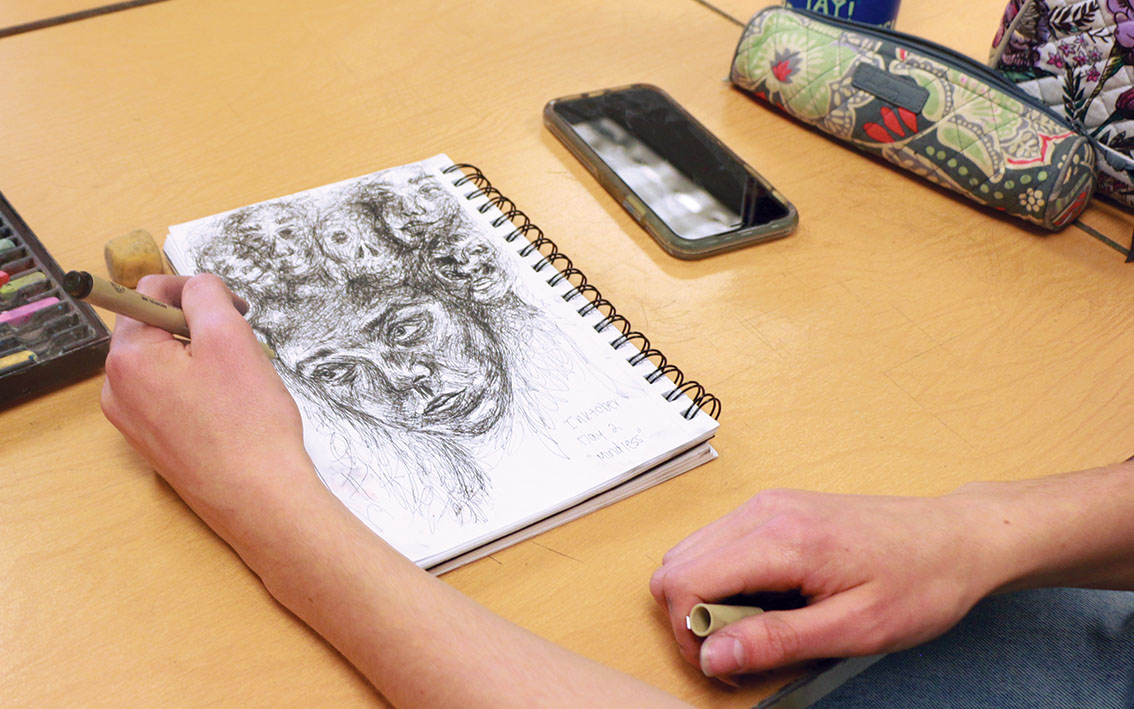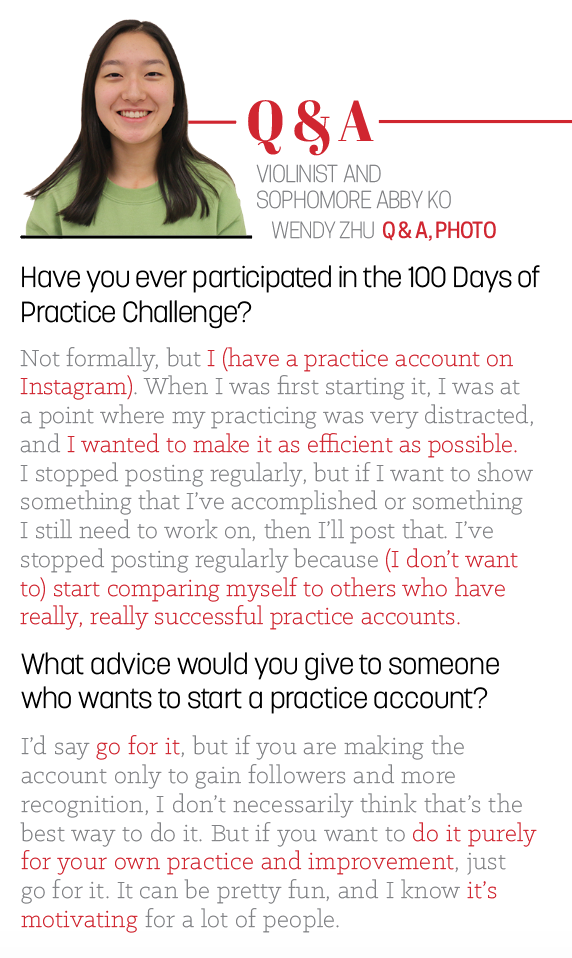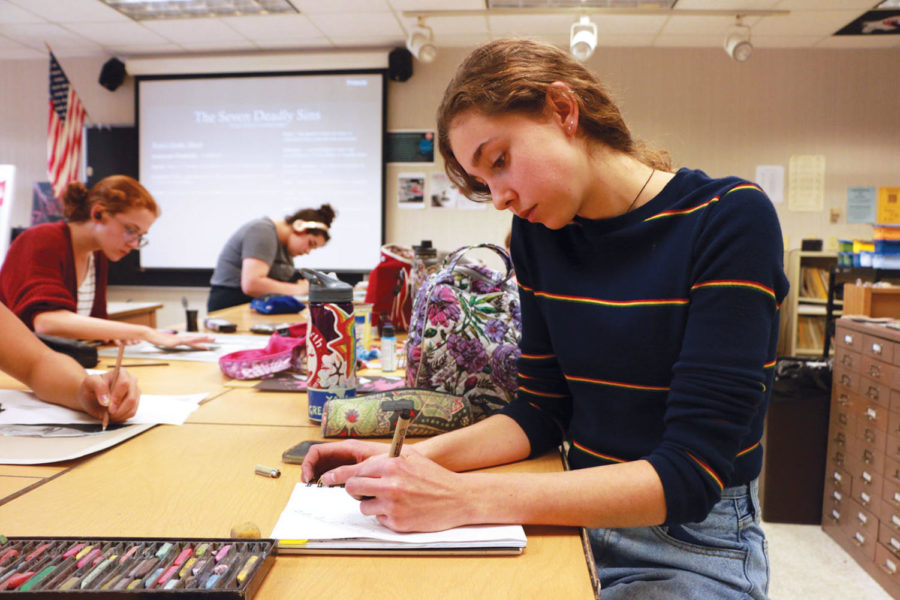Each year since 2009, artists all over the world pick up their pens every day in October to draw. They may be following a prompt or they may simply be drawing whatever comes to mind, but all are part of the international Inktober challenge.
In 2009, Jake Parker, Utah-based illustrator, writer and teacher, started Inktober as a way to improve his skills with ink and develop better habits. Every year, an official prompt list is posted on the Inktober website and social media with one word to inspire each day’s drawing. This year’s first prompt, for example, was “ring.” Participants may then interpret that prompt however they like, and draw something in ink based off of it. Many choose to post their work on social media.

Lexi Carter, Art Club president and junior, finishes her Inktober drawing. Each day of October has its own Inktober prompt. Carter’s prompt on Oct. 2 was “Mindless.”
Freshman Lizzie Farrell said she will be participating in the Inktober challenge this year for the third time.
“I think (Inktober is) a good thing to participate in, ” Farrell said. “I really like Inktober because if you’re (in) an art block, it kind of helps you if you need a little step (or) a push. I’m not in the most creative mindset right now (and) it helps you come up with ideas.”
Inktober is not the only challenge on the internet promoting positive habits and practice. In 2010, the “Piano Explorer” magazine challenged piano students to practice their instrument for 100 days in a row, and then, with the help of their teachers, submit their names to be published in the magazine. Now, it’s possible to visit the Piano Explorer’s website and find hundreds of names listed by year and number of days, displaying the achievements of students who have practiced for as many as 2,000 days in a row. The challenge has extended to others as well. Violinists, cellists and even actors make the commitment and share their progress on social media.

Another such online challenge is National Novel Writing Month, also known as “NaNoWriMo.” Officially taking place in November, the challenge encourages authors of all ages to write every day of the month in order to finish a novel by December. Every year, over 300,000 people participate, and NaNoWriMo is now a nonprofit organization that, according to the website, “runs year-round programs across 646 regions around the world and in thousands of classrooms, and empowers nearly half a million people to access the power of creative writing.”
When junior Isabelle “Izzy” Woodward was in eighth grade, she was given a choice. For points, she could either write a book report or a NaNoWriMo project with a goal of 10,000 words per day. Woodward chose NaNoWriMo.
Even after eighth grade, she continued to write.
“Freshman year, I wanted to start writing a little novel just for fun. And (NaNoWriMo) just kind of helped progress it because it gave me a time that I needed this many words by, or by so long and how many words I had to write a day,” Woodward said.

Online challenges like Inktober, 100 Days of Practice and NaNoWriMo can have a number of benefits for artists and students.
Jennifer Bubp, art teacher and Art Club sponsor, said that she is considering implementing aspects of Inktober into her classes and the Art Club’s regular activities.
“I just love the idea of having a space where students can just create,” Bubp said. “I love the idea of—even at home, maybe it’s just a five minute homework prompt—(taking) time out of your day and (being) in the moment, and it helps you to center. Maybe something in your room or a shoe in your closet, something to just kind of bring you back to the now rather than worrying about the future (or) thinking about the past.”
On top of that, it can be helpful for students to practice their art—whether it is in a written or visual form—every day.
“It’s really nice for people to get into a routine of having that habit they do every day,” Woodward said, even if that just means taking a 10-minute “brain break” after school to write. “It just ends up progressing into this thing that only gets bigger and better. And so it helps people mentally if they have that routine. Like, I know I have this routine, even if everything else goes wrong.”

Lexi Carter, Art Club president and junior, said she is using Inktober this year to build her portfolio and her skills.
“I’m starting to do more painting and working (on) expanding my mediums,” she said. “I’m (also) working on a portfolio for AP Studio (Art), and when projects take a really long time, I feel like I need to fall back on a medium that I can do quickly, but still get good results from.” She plans to bring some of her work from Inktober to national portfolio day, in which students meet with colleges to show their art.
Perhaps, to some, making the commitment to take time for practice every day may seem impossible. But Farrell assured that there is no reason to rush.
“(Inktober) brings everybody together because we’re all doing it together and able to see other people’s (work),” she said. “It’s really a fun time.”
































![What happened to theater etiquette? [opinion]](https://hilite.org/wp-content/uploads/2025/04/Entertainment-Perspective-Cover-1200x471.jpg)














































![Review: “The Immortal Soul Salvage Yard:” A criminally underrated poetry collection [MUSE]](https://hilite.org/wp-content/uploads/2025/03/71cju6TvqmL._AC_UF10001000_QL80_.jpg)
![Review: "Dog Man" is Unapologetically Chaotic [MUSE]](https://hilite.org/wp-content/uploads/2025/03/dogman-1200x700.jpg)
![Review: "Ne Zha 2": The WeChat family reunion I didn’t know I needed [MUSE]](https://hilite.org/wp-content/uploads/2025/03/unnamed-4.png)
![Review in Print: Maripaz Villar brings a delightfully unique style to the world of WEBTOON [MUSE]](https://hilite.org/wp-content/uploads/2023/12/maripazcover-1200x960.jpg)
![Review: “The Sword of Kaigen” is a masterpiece [MUSE]](https://hilite.org/wp-content/uploads/2023/11/Screenshot-2023-11-26-201051.png)
![Review: Gateron Oil Kings, great linear switches, okay price [MUSE]](https://hilite.org/wp-content/uploads/2023/11/Screenshot-2023-11-26-200553.png)
![Review: “A Haunting in Venice” is a significant improvement from other Agatha Christie adaptations [MUSE]](https://hilite.org/wp-content/uploads/2023/11/e7ee2938a6d422669771bce6d8088521.jpg)
![Review: A Thanksgiving story from elementary school, still just as interesting [MUSE]](https://hilite.org/wp-content/uploads/2023/11/Screenshot-2023-11-26-195514-987x1200.png)
![Review: "When I Fly Towards You", cute, uplifting youth drama [MUSE]](https://hilite.org/wp-content/uploads/2023/09/When-I-Fly-Towards-You-Chinese-drama.png)
![Postcards from Muse: Hawaii Travel Diary [MUSE]](https://hilite.org/wp-content/uploads/2023/09/My-project-1-1200x1200.jpg)
![Review: "Ladybug & Cat Noir: The Movie," departure from original show [MUSE]](https://hilite.org/wp-content/uploads/2023/09/Ladybug__Cat_Noir_-_The_Movie_poster.jpg)
![Review in Print: "Hidden Love" is the cute, uplifting drama everyone needs [MUSE]](https://hilite.org/wp-content/uploads/2023/09/hiddenlovecover-e1693597208225-1030x1200.png)
![Review in Print: "Heartstopper" is the heartwarming queer romance we all need [MUSE]](https://hilite.org/wp-content/uploads/2023/08/museheartstoppercover-1200x654.png)




